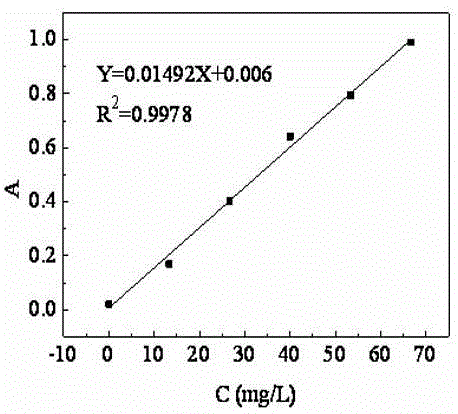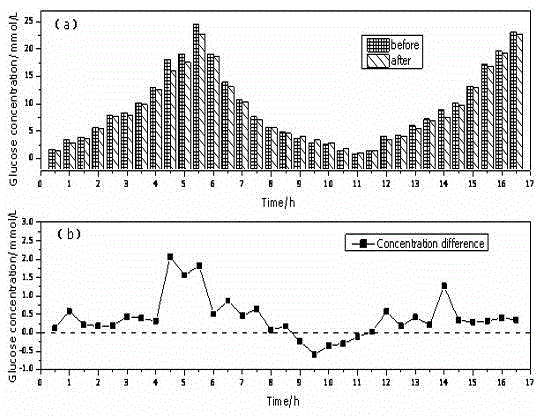Method for preparing gold surface boric acid glucose-based sensitive hydrogel and application thereof
A glucose-sensitive, hydrogel technology, applied in chemical instruments and methods, other chemical processes, etc., can solve the problems of poor sensitivity, poor glucose sensitivity, and narrow linear range of glucose response detection, and achieve the effect of good sensitivity
- Summary
- Abstract
- Description
- Claims
- Application Information
AI Technical Summary
Problems solved by technology
Method used
Image
Examples
Embodiment 1
[0021] Example 1: (1) Surface pretreatment of gold flakes: put the gold metal flakes in the prepared Piranha reagent (Piranha), ultrasonically clean them for 15 minutes, then ultrasonically clean them with acetone, ethanol, and double-distilled water for 10 minutes, and blow them with N2. dry; wherein, the configuration of Peel's reagent is concentrated H2SO4: H2O2=5: 3 (V: V); (2) amination: dissolve 3-aminopropyltrimethoxysilane in toluene, and the treated gold Place in the above solution under a nitrogen atmosphere, react at 110 °C for 12 h, rinse the gold sheet with absolute ethanol and double distilled water in sequence, and blow dry with N2; the concentration of the silane coupling agent is 3 mmol / L; (3) Polymerization: Add 3-acrylamidophenylboronic acid, ethylene glycol dimethacrylate, diphenyl ketone and acrylamide into dimethyl sulfoxide, mix well, and pipette with a micro syringe 15 uL of the mixed solution was evenly coated on the gold sheet described in step (2), u...
Embodiment 2
[0023]Example 2: (1) Surface pretreatment of gold wafers: place gold-plated silicon wafers in prepared Piranha reagent (Piranha), ultrasonically clean for 30 min, and then ultrasonically clean with acetone, ethanol, and double-distilled water for 10 min, respectively, and argon gas Blow dry; Among them, the configuration of Peel's reagent is concentrated H2SO4: H2O2=7: 3 (V:V); (2) Amination: Dissolve a certain amount of 3-aminopropyl triethoxysilane in ethanol, and The treated gold flakes were placed in the above solution under a nitrogen atmosphere. After reacting at 78 °C for 5 h, the gold flakes were rinsed with anhydrous ethanol and double distilled water in turn, and dried with argon. Among them, the concentration of the silane coupling agent 5 mmol / L; (3) Polymerization: 3-acrylamidophenylboronic acid, N,N-methylenebisacrylamide, 2,4-diethylthioxanthone and acrylamide were added to acetonitrile, mixed After uniformity, use a micro-syringe to pipette 5 uL of the mixed so...
Embodiment 3
[0024] Example 3: (1) Surface pretreatment of gold wafers: place the gold-plated silicon wafers in prepared Piranha reagent (Piranha), ultrasonically clean them for 60 min, then ultrasonically clean them with acetone, ethanol, twice distilled water for 10 min, and helium Blow dry; Among them, the configuration of Peel's reagent is concentrated H2SO4: H2O2=4: 3 (V: V); (2) Amination: Dissolve a certain amount of γ-aminopropylmethyldiethoxysilane in the volume ratio 1:1 ethanol and distilled water, put the treated gold flakes in the above solution, nitrogen atmosphere, react at 50 °C for 12 h, rinse the gold flakes with absolute ethanol and double distilled water successively, and helium Blow dry; where, the concentration of γ-aminopropylmethyldiethoxysilane = 4 mmol / L; (3) Polymerization: 3-acrylamidophenylboronic acid, ethylene glycol bisacryloyl ester, a, a - Dimethoxy-a-phenylacetophenone and acrylamide were added to acetone, and after mixing evenly, pipette 30 uL of the mix...
PUM
| Property | Measurement | Unit |
|---|---|---|
| diameter | aaaaa | aaaaa |
| wavelength | aaaaa | aaaaa |
Abstract
Description
Claims
Application Information
 Login to View More
Login to View More - R&D
- Intellectual Property
- Life Sciences
- Materials
- Tech Scout
- Unparalleled Data Quality
- Higher Quality Content
- 60% Fewer Hallucinations
Browse by: Latest US Patents, China's latest patents, Technical Efficacy Thesaurus, Application Domain, Technology Topic, Popular Technical Reports.
© 2025 PatSnap. All rights reserved.Legal|Privacy policy|Modern Slavery Act Transparency Statement|Sitemap|About US| Contact US: help@patsnap.com



